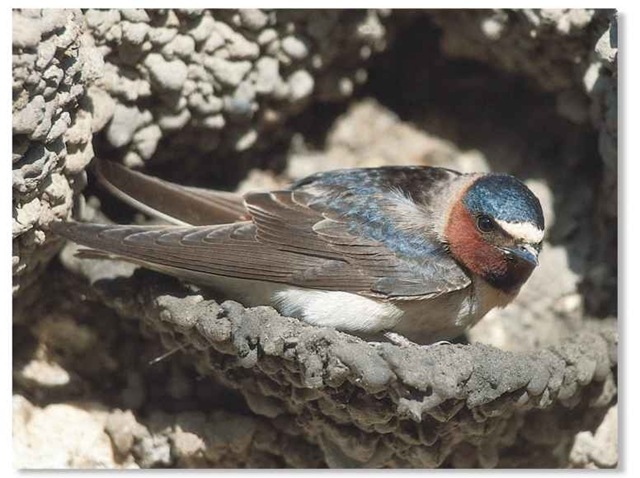ORDER
Passeriformes
FAMILY
Hirundinidae
GENUS & SPECIES
KEY FEATURES
• Elegantly colored small bird that forages for insect prey while in flight
• Chases after swarms of insects with its tiny mouth wide open
• Groups gather mud to build nests in colonies on cliffs, canyons, bridges or buildings
WHERE IN THE WORLD?
Found in North America, from Alaska south throughout most of the U.S. to central Mexico; winters in South America from Brazil to Argentina

LIFECYCLE
The extremely social American cliff swallow’s life revolves around its flock: it forages, preens, gathers mud, sunbathes, nests, migrates and winters in large groups.
HABITAT
The cliff swallow migrates to its North American breeding grounds, arriving from March to May True to its name, the bird has historically nested on the sides of steep cliffs. Though the cliff swallow still settles along the cliffs and canyons of western North America, it has adapted to alternative nesting sites across the U.S.: many bridges, dams or buildings offer protective overhangs and suitable vertical surfaces on which to attach a nest. Swallows also need open areas for foraging and a water source for the mud necessary to build their nests. In the fall, the birds and their young are among the y Historical site earliest migrants south; large Cliff swallows often return flocks fly to South America. to cliffs each year.

Cliff swallows choose mud with high clay and silt content; this makes the nest less likely to crumble when dry, important when walls are shared.
Cliff swallows often trespass into each other’s nests. Most do nothing once inside, but occasionally one will steal fresh mud or toss an egg out of the nest.
BEHAVIOR
American cliff swallows are very social. Large flocks forage together in flight throughout the day; birds have been timed at up to almost 30 mph. In cool and cloudy weather; the swallow gives a “squeak” call to announce the discovery of an insect swarm.This call attracts other birds to the food source.
The birds preen their feathers and sunbathe together at their daytime perches on wires, small twigs and rooftops, and they roost together at night, clinging to reeds and tall grasses.
To protect their young against enemies, such as American kestrels, black-billed magpies, bull snakes and rats, the cliff swallows build sheltered nests in large colonies. Central nests are sought after, because the nests at the edges of a colony are more vulnerable to attack. But there is not always safety in numbers: very large, conspicuous colonies attract predators. Cliff swallows usually give alarm calls and surround the predator in a loose group to drive it off.
CONSERVATION
American cliff swallows are abundant throughout their range and are currently not threatened.Their adaptability in nesting sites has led to the expansion of their range across the United States.
FOOD & FEEDING
The American cliff swallow feeds entirely on insects caught in flight. The bird chases after flying ants, wasps, grasshoppers, dragonflies, mosquitoes and beetles, including the destructive cotton-boll weevils; the swallow’s menu includes 84 insect families from 10 orders.The bird holds its tiny gaping mouth as wide as it can to scoop up hundreds of insects as it darts along.
Foraging in large groups of up to 2,000 birds, the cliff swallow searches for swarms of insects.The birds tend to focus on areas of relatively high altitudes; however, in cool and cloudy weather the cliff swallows feed just above the ground or water surface due to lack of visibility and decreased availability of swarming insects. In this damp and dreary climate, the bird tends to forage alone. Groups always tend to follow each other; if one is feeding on a big swarm, another will follow to scout out the area. This holds true for solitary feeding birds as well. American cliff swallows never have a problem sharing their food sources.
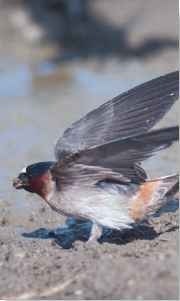
A More mud The American cliff swallow gathers mud pellets, one by one, to build its nest.
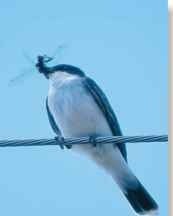
Food first A swallow captures a dragonfly in flight, but returns to a perch to enjoy its huge meal.
BREEDING
Cliff swallows arrive at their breeding areas by May.The birds are more comfortable in flight; on land, they shuffle along when gathering mud to build their mud nests. They often reuse nests left from the previous summer and need to add mud only to the nest’s entrance, a narrow tunnel that usually points downward. The cliff swallow generally nests in dense colonies on cliffs, banks, dams and bridges; groups of several thousand nests have been observed. Swallows often fight for safer, centrally located nests in these colonies. The female swallow incubates the 4-5 eggs for up to 16 days; after hatching, the chicks are able to fly by 24 days, but still rely on their parents for food.The juveniles gather to form large creches and depart with their parents for wintering grounds from July to September
Cute couple A male cliff swallow joins the female for added protection as she incubates the 4—5 eggs inside her cliffside nest.
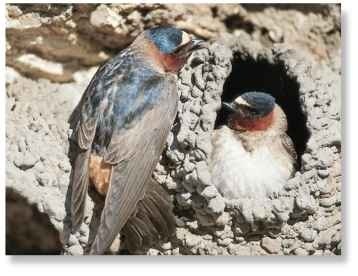
CLOSE NEIGHBORS
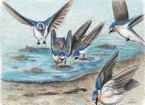
1 Collection
American cliff swallows collect mud pellets for their nests along the shallow muddy margins of a pond.
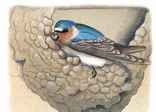
2| Construction
A male transports the mud in his bill back to his nest and adds it to the lip on the walls of the slowly forming cup-shaped structure.
^Dense colony Hundreds of nests are packed close together.
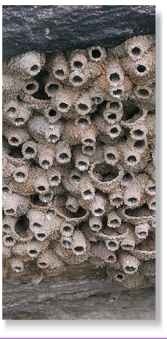

3 Production
Many cliff swallows have built their nests on the underside of the bridge.All birds within the colony are at the same stage of breeding.

4 Protection
Juveniles from many colonies form a protective creche and gather along a telephone wire, anxiously awaiting their parents’ return.
Profile
American Cliff Swallow
The American cliff swallow is an accomplished aerialist; if it’s not gathering mud for its nest, the bird is usually in the air.
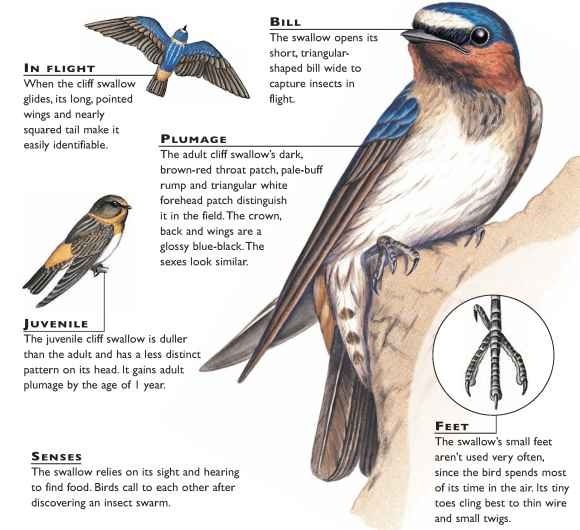
CREATURE COMPARISONS
Measuring up to 6″, the Angolan swallow (Hirundo angolensis) is similar in size to the American cliff swallow. However; the bright-blue Angolan swallow has a rufous-colored throat patch that extends to the breast and a well-forked tail, unlike the cliff swallow, which has a smaller throat patch and squared tail.The Angolan swallow forages in small groups in Africa, far from the large flocks of cliff swallows in North and South America.

| VITAL STATISTICS | |
| Weight | 0.7-1.0 oz. |
| 1 1 Length |
5.5″ |
| i Wingspan | 12-12.25″ |
| Sexual Maturity | About 1 year |
| i Breeding I Season | April-August |
| Number of Eggs | 4-5 |
| Incubation Period | 14-16 days |
| Fledging Period | 21-24 days |
| Breeding Interval | Up to 3 broods per season |
| Typical Diet | Insects, especially beetles; also flying ants, wasps and grasshoppers |
| Lifespan | Over 5 years |
RELATED SPECIES
• The American cliff swallow is one of eight species of swallow in North America. The bird was once placed in the genus Petrochelidon, but this was merged with Hirundo. The genus Hirundo includes birds that build an open, cup-shaped nest. One of the most common is the barn swallow, H. rustica. The Hirundinidae family includes 79 species of swallow and martin.
